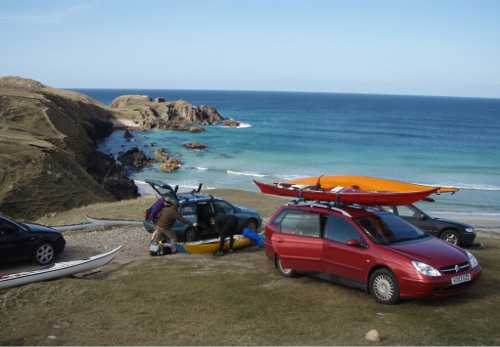Buying equipment
A set of sea kayaking equipment is expensive but lasts for many years. We costed the main items in January 2010, choosing mid-range products in the USA, Britain and France. The prices are in local currencies.
| USA ($) | Britain (£) | France (€) | |
| Classic sea kayak (polyethylene / composite) | 1750/3000 | 1250/2000 | 1200/1750 |
| Paddle | 100 | 50 | 75 |
| Sprayskirt | 125 | 50 | 75 |
| PFD | 100 | 50 | 75 |
| Wetsuit | 135 | 100 | 150 |
| Footwear | 50 | 40 | 60 |
| Waterproof jacket (simple / drytop) | 100/200 | 50/75 | 50 / 150 |
| Synthetic base-layer shirt | 75 | 40 | 50 |
| Tow-belt | 40 | 25 | 75 |
| Total (minimum / maximum) | $2475/3825 | £1655/2430 | €1790/2440 |
Exchange rates at the time were $1.54 = £1.00 = €1.05 so the total cost was approximately the same in each country. Composite kayaks were a little cheaper in France.
There’s really no need to have jewel-like equipment made of vac-bagged Kevlar or carbon fiber, vinylester or epoxy resin, Alaskan Sitka spruce, fragile latex or expensive Gore-Tex. The cheaper alternatives of E-glass, polyester, polyethylene, plywood, Douglas fir, neoprene and PVC-coated nylon are absolutely fine. If you want to use your kayak, not keep it in a nitrogen atmosphere in a glass case, there’s a lot to be said for budget equipment.
You may be able to find secondhand sea kayaking equipment, or you can halve the price by making your own, which is also very satisfying. See:
• Build Your Own Kayak In Fiber-Reinforced Plastic
• Build Your Own Wood Kayak
• Build Your Own Skin-On-Frame Kayak
• Make A Greenland Paddle
Equipment checklists
We recommend this equipment for practical reasons. You may in addition be legally required to carry certain items at all times. Please check the latest regulations for your area. Last time we checked they were as follows:
In the USA requirements vary from state to state. Sea kayakers are usually required to carry a USCG-approved PFD (buoyancy aid or lifejacket), a whistle or foghorn, and a white light visible one mile away if out between sundown and sunrise. Flares or a strobe light may be required. In some states it is compulsory for the PFD to be worn, not just carried, if the kayaker is under a certain age or is out in the winter months. See Personal Buoyancy.
In Canada, sea kayakers are required to have a PFD, a 15-meter throwline, a bailer or hand pump, a whistle or foghorn, and a white light if out between sundown and sunrise or in conditions of reduced visibility. If you carry a VHF radio you need an operator's certificate. Source: Transport Canada Sea Kayaking Safety Guide.
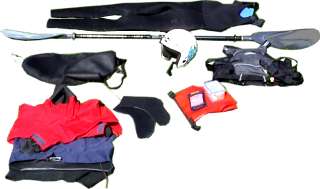 Equipment for a short, easy day trip
Equipment for a short, easy day trip
For a trip by experienced kayaker(s), in familiar sheltered waters, nice weather.
• Kayak with adequate flotation. See The Sea Kayak and Additional Flotation For Your Kayak.
• Hatch covers.
• Paddle.
• Sprayskirt.
• Suitable clothing for the time of year. For example, a waterproof jacket worn over a swimsuit, synthetic base-layer shirt, farmer John/Jane wetsuit and wetsuit boots. See Kayak Clothing.
• PFD with whistle attached. See Personal Buoyancy.
• Tow-belt.
• Safe storage for your keys (a short cord to attach them to an anchor loop inside the pocket of your PFD, or a lanyard so you can wear them round your neck under your jacket).
• Straps and pads to hold your kayak onto a roof rack. See Transporting Your Kayak.
If appropriate also:
• Waterproof wristwatch. More useful than you might think. See Timing.
• A note of the time of high tide.
• Spare paddle. GROUP.
• Portable pump for rescue within group. See Built-In Pump vs. Portable Pump. GROUP.
• Dry bag with Small Repair Kit and Small First Aid Kit. GROUP.
• Stirrup (rope or webbing sling) for deep-water rescue.
• Paddle float for solo self-rescue.
• Towel for changing on a parking lot.
• Waterproof bag or crate to carry your wet equipment back home.
• Drink and snack.
• Hat.
• Factor 30 sun cream, factor 50 sun stick for lips and nose, sunglasses. See Clothing For Summer.
• Retainer cord for your glasses.
• Money for parking or café.
• Risk assessment checklist.
| When carrying safety equipment which may be needed at sea, try not to stow it in a way which may force you to take off your sprayskirt or a deck hatch. See Stowing Equipment In A Sea Kayak. |
Equipment for an intermediate day trip
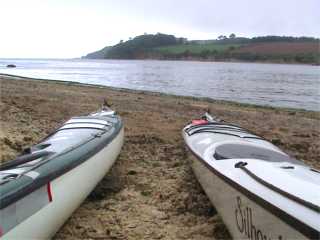 For example, a trip in cold weather, or where one of the group may well end up swimming or get exhausted, or a safe haven will be more than a few minutes away if the weather deteriorates, or any damage to a kayak would involve more than just getting a taxi home.
For example, a trip in cold weather, or where one of the group may well end up swimming or get exhausted, or a safe haven will be more than a few minutes away if the weather deteriorates, or any damage to a kayak would involve more than just getting a taxi home.
You will need most of the equipment listed above, plus:
• Cellular phone in small transparent dry bag.
• Map on scale of 1:50,000 or larger.
If appropriate also:
• Navigation tools for use at home. Apart from a map and wristwatch you will need most or all of these: Nautical chart on 1:25,000 or 1:50,000 scale, tide tables, sailor's or kayaker's pilot guide to the area, current atlas, pencil, eraser, course plotter, and a ruler or dividers.
• Navigation tools for use at sea. For use at sea, waterproof map and chart extracts, a handheld compass with fairly long baseplate, waterproof marker, and a white self-adhesive plastic patch just in front of your cockpit for writing navigational notes.
• Printout of weather forecast and synoptic chart. See Predicting The Weather. GROUP.
• Spare paddle for each kayak.
• Dry bag containing Big Repair Kit and Big First Aid Kit. GROUP.
 • Small knife. Suitable for opening packets, making sandwiches, getting stones out of a skeg box, cutting away the damaged part of a paddle or kayak, cutting a patch to shape for an emergency repair, gutting fish. GROUP. For example a whitewater kayaker's river knife, sailor's folding clasp-knife or diver's small sheath-knife.
• Small knife. Suitable for opening packets, making sandwiches, getting stones out of a skeg box, cutting away the damaged part of a paddle or kayak, cutting a patch to shape for an emergency repair, gutting fish. GROUP. For example a whitewater kayaker's river knife, sailor's folding clasp-knife or diver's small sheath-knife.
• Waterproof VHF radio in small transparent dry bag (they're not really waterproof). GROUP.
• Note of phone numbers of friends ashore and radio channels of local Coast Guard, harbormaster of major naval or commercial port, weather broadcasts, etc. GROUP.
• Copy of any float plan you left with friends ashore. GROUP.
• Flares and smoke. GROUP.
• Xenon strobe light(s).
• A note of any medical condition (asthma, diabetes, severe allergy, epilepsy, hemophilia) to which any of group is vulnerable, and what to do if it causes trouble. GROUP.
• Medication for any vulnerable group member (asthma inhaler, glucose tablets, adrenaline, etc).
• Survival bag or group shelter. GROUP.
• Comfort items such as a hot drink in vacuum flask. GROUP.
• Waterproof pants to keep you warm on the beach.
• Hat, scarf, mitts.
If you are leading a group which includes young, inexperienced or possibly ill-equipped kayakers, consider also:
• Spare warm clothing for other people. In cool weather, a small drybag with a selection of hats, scarves & mitts. In cold weather, a medium-sized drybag for each kayaker containing a full set of dry synthetic clothing.
• Spare floppy sprayskirt with adjustable elastic at waist and hem, large enough to fit any ordinary kayak cockpit. GROUP.
• Spare paddle jacket, big enough to go over a PFD, in case somebody starts getting cold while you are on the water. This could be just an XXXL paddling jacket. If it also has an elasticated hem that’s long enough to fit over a cockpit coaming, like a tuiliq, it may be called a “storm cag”. GROUP.
Equipment for an advanced day trip
See Formal Navigation For Advanced Trips.
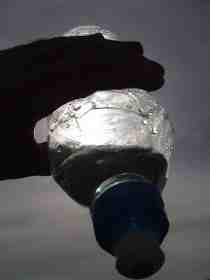 You will need most of the equipment listed above, plus if appropriate:
You will need most of the equipment listed above, plus if appropriate:
• GPS satellite navigation device in small transparent dry bag. GROUP.
• Deck compass in addition to the regular handheld compass.
• In case of night kayaking, a large and powerful flashlight, batteries for the light built into your deck compass, and a waterproof headlamp.
• Half a sleeping pad of 3/8" polyethylene foam. GROUP.
• Selection of drybags, large and small.
• 24 hours worth of food. See Camp Food.
• 24 hours worth of drinking water. That's about a gallon each.
If you are going to play on seriously fast-moving water you may also need:
• Whitewater playboat instead of your sea kayak.
• Whitewater PFD with quick-release "chest harness" belt, cow's tail and carabiner
• Throwline(s). If you use a rope on white water, make sure you can easily reach a knife.
Equipment for a multi-day trip in a wilderness area
Try to take the smallest, lightest load you can. However you will need most of the equipment listed above, plus something for safe and pleasant shelter, sleeping, eating and drinking. Elsewhere we look at:
• Shelter and hygiene. Tent, sleeping pad, sleeping bag, toilet bag, seat, insect equipment, binoculars.
• Food and drink . Water container, water purification, stove, fuel, matches, cooking pots, knife, chopping board, garbage bags, food supplies, equipment for fishing, equipment for campfire.
In general see Overnight trips.
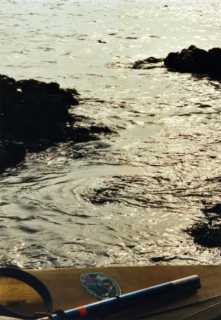 Travelling light
Travelling light
Frustra fit per plura quod potest fieri per pauciora. (It's a waste to use more to achieve what you can do with less.)
William of Occam, Summa Totius Logicae, 1340
Highly experienced kayakers often seem to be polarized into those who carry a lot of equipment and a large minority who carry only a drink, a sandwich and a roll of sticky tape.
The minimum you need is a strong kayak with bulkheads and/or other adequate flotation and deck rigging; a strong paddle; a good sprayskirt; kayak clothing which will keep you functional if you spend 15 minutes in the water; a tow-belt; and a roll of sticky tape as both First Aid kit and repair kit.
As previously mentioned, some equipment is legally required in the USA and Canada.
One of everything would be a hat, mobile phone, VHF radio, GPS, handheld compass, deck compass, chart case, wrist altimeter/ barometer, sunscreen, lip salve, mitts, scarf, EPIRB, xenon strobe, radar reflector, flares, heliograph, compressed-air foghorn, spare paddle, pump, paddle float, rescue sling, Leatherman multi-tool, throwline, carabiner, First Aid kit, repair kit, dry clothing, survival knife, emergency shelter, camping pad, survival bag with fire-starter, fishing kit, head torch, Cyalume lightstick, rolling aid, nose clip, pocket anemometer, hydrophone, echo sounder, sea anchor, waterproof notebook, camera, binoculars, waterproof MP3 player, tissues, muesli bars, apple, sandwiches, drink, money, credit cards, house keys, lock for your kayak, and keys to your vehicle. With all that it would be hard to stand up.
The health & safety argument
"If you carry safety equipment you will be safer. If you have an accident you should be able to do something about it, and if you can't sort it out yourself you should be able to call for help. "
This argument is perhaps most popular with managers, inspectors, examiners and lawyers who don’t have to buy, lift, carry, stow, wash, maintain and repair all this gear.
The minimalist argument
"If you carry safety equipment you will think you are safer. If you carry enough to deal with all foreseeable accidents you are more likely to have an accident."
It's a point of view. Is it valid?
The debate
Those who support the minimalist argument say that there’s no evidence that the “health & safety approach” reduces the number or seriousness of injuries; the Talisman Effect may mean it does exactly the opposite; and a need to carry lots of equipment puts people off kayaking.
Kayak damage . Most kayakers hit rocks from time to time when we're out paddling. Usually the kayak bounces off without damage, but a heavily-loaded kayak is likely to be damaged by impact.
Deep-water rescue . Any kayak may fill with water and need to be emptied or repaired at sea. This will be a lot harder if it is full of equipment, even lightweight equipment such as spare clothing, First Aid kit, etc.
Staying upright. It is much easier to roll a kayak if you don’t have 18 lbs of water trapped in the pockets and hood of your full-feature added-value top-of-the-line paddling jacket, 10 lbs of water in the pockets of your top-of-the-line PFD, 2 lbs in a deck bag and another 2 lbs in a hydration system strapped to your back.
There's also the Talisman Effect. People who strap on a full set of safety equipment feel safe, so they're more likely to paddle in conditions for which they don't yet have all the skills.
There's a legal insurance advert which shows a rock climber standing at the top of a cliff, right at the edge. It's a nice sunny day, there's a lovely view, lying on the ground are professional rucksacks, racks of hardware and coils of brightly-coloured rope, the climber's wearing a helmet and a harness, and he's looking cool. The climber (and the insurance company) think he's safely tied on to an anchored rope, but he's not attached to anything at all. He's inches from serious injury or death. This is how most "climbing" accidents happen - strap on a harness, feel safe, get careless, fall while walking to or from the cliff. The Talisman Effect is also well documented on the highway, by analysis of accident statistics before and after the introduction of compulsory seat-belts. Drivers wearing seat-belts go faster and take more risks. They come out of it OK, because they're sitting in a safe cockpit with crumple zones and air-bags, but they injure more pedestrians and cyclists. A kayak cockpit has no built-in safety, so kayakers just have to avoid violent impacts and long swims.
Kayaking safety doesn't come in a box. 99.99% of it comes from alertness, experience and common sense.
Cost and amenity. Every item of equipment costs money, has some weight and bulk, and needs to be washed and put away afterward. If you have items attached to the deck of your kayak or tucked inside the cockpit, and you capsize during a forced landing through surf, they may be lost.
The idea that it doesn’t matter how much weight you load into your kayak because it will all float is a myth. The deeper a boat floats, the harder it is to drag through the water; and the heavier it is, the slower it will be to rise to a wave. Kayak racers will pay twice as much for a boat that’s 10 pounds lighter, and any sail racer will tell you that if you want to win a race, get all the accumulated junk out of your boat before you enter.
The more equipment you have to buy, wear, carry and maintain the less often you will go kayaking. And if kayaking equipment is expensive it will (and does) put many people off trying the sport.
| Go to next page for: • Choosing a sea kayak • Classic sea kayak • Intended use • Five styles of classic sea kayak • Will this kayak be stable enough for me? • Sea kayak features |
